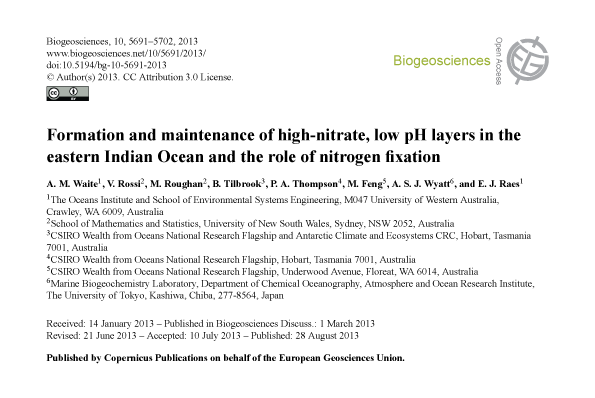Formation and maintenance of high-nitrate, low pH layers in the eastern Indian Ocean and the role of nitrogen fixation
A. M. Waite, V. Rossi, M. Roughan, B. Tilbrook, P. A. Thompson, M. Feng, A. S. J. Wyatt, and E. J. Raes
We investigated the biogeochemistry of low dissolved oxygen high-nitrate (LDOHN) layers forming against the backdrop of several interleaving regional water masses in the eastern Indian Ocean, off northwest Australia adjacent to Ningaloo Reef. These water masses, including the forming Leeuwin Current, have been shown directly to impact the ecological function of Ningaloo Reef and other iconic coastal habitats downstream. Our results indicate that LDOHN layers are formed from multiple subduction events of the Eastern Gyral Current beneath the Leeuwin Current (LC); the LC originates from both the Indonesian Throughflow and tropical Indian Ocean. Density differences of up to 0.025 kg m−3 between the Eastern Gyral Current and the Leeuwin Current produce sharp gradients that can trap high concentrations of particles (measured as low transmission) along the density interfaces. The oxidation of the trapped particulate matter results in local depletion of dissolved oxygen and regeneration of dissolved nitrate (nitrification). We document an associated increase in total dissolved carbon dioxide, which lowers the seawater pH by 0.04 units. Based on isotopic measurements (δ15N and δ18O) of dissolved nitrate, we determine that ~ 40–100% of the nitrate found in LDOHN layers is likely to originate from nitrogen fixation, and that, regionally, the importance of N-fixation in contributing to LDOHN layers is likely to be highest at the surface and offshore.

